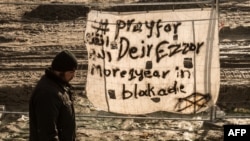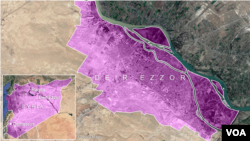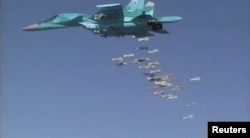In a race with the Russia-backed Syrian government forces and Shiite militia groups to capture the eastern city of Deir ez-Zor from Islamic State militants, a Syrian rebel group supported by the U.S. claims it is in talks with the U.S.-led coalition to relocate its fighters to northern Syria.
Such a move would better position the rebel group in its attempt to recapture the city, which is under IS control, they said.
Officials from Jaish Maghawir al-Thawra (MaT), also known as Revolutionary Commando Army, a Syrian opposition militia supported by Washington, told VOA on Friday that the group was negotiating with the U.S.-led coalition to transport members of the group to the northern Syrian town of al-Shaddadi, roughly 55 miles northeast of Deir ez-Zor.
"We are trying to form a national army with other rebel groups in al-Shaddadi and our aim is to head towards Deir ez-Zor," Rabee Hamidi, the spokesman of the MaT rebel group, told VOA.
Hamidi added that the talks included discussion on possible routes to move the fighters who are currently stationed near al-Tanf base, which sits in the tri-border area of Syria, Jordan and Iraq.
"The international coalition will either secure a safe land passage to al-Shaddadi or transport the fighters by helicopters," Hamidi said.
U.S. response
Citing "operational security" and "tactical surprise" as reasons, Colonel Joseph Scrocca, the U.S.-led coalition spokesman, told VOA he could neither confirm nor deny the talks, but he did acknowledge the existence of close coordination between the U.S-led coalition and MaT in the fight against IS in Syria's eastern region.
"The MaT is a trusted partner and an effective fighting force in the counter-Daesh campaign," Scrocca said, using another acronym for IS, adding, "We will continue to support their efforts to defeat Daesh in Syria."
Last month, U.S. President Donald Trump ended a clandestine American program to provide arms and supplies to some Syrian rebel groups in southern Syria near Deir ez-Zor. The decision ended support for armed groups such as Lions of the East Army, which was mainly focused on battling the Syrian regime forces.
But the U.S. continues its backing of other rebel groups, such as MaT, which concentrate on fighting IS in Deir ez-Zor.
Importance of Deir ez-Zor
Deir ez-Zor is the largest city in eastern Syria. It is situated in the middle of an oil-rich province by the same name.
The province was home to over 1 million, with nearly 210,000 people living in the city, before the Syrian civil war started in 2011 in the aftermath of the Arab Spring.
But because of years of conflict between the Syrian government forces and the Syrian opposition groups, and the emergence of extremist groups like IS, hundreds of thousands of people have been forced to flee. An estimated half-million civilians still live under IS, which has controlled most of the province since mid-2014.
The Syrian regime remains in control of a pocket within the city, including its air base, which IS has fought to control for nearly three years without success.
Competing stakeholders
Expelled from Mosul and other key territories in Iraq and Syria, and losing ground in their self-proclaimed capital, Raqqa, IS jihadists are coming under increasing pressure in Deir ez-Zor as well.
What makes the fight against IS in Deir ez-Zor particularly complicated is the fierce competition between the U.S.-backed rebel groups and the Syrian regime, supported by Russian and Iranian-allied Shiite militias.
Observers charge that the control of Deir ez-Zor will allow Iran and its Shiite allies an easy access to Syria via Iraq, in addition to the province's natural resources revenues.
Meanwhile, the U.S. and its coalition partners, which control Syria's southern border point with Jordan and Iraq, have been supporting the Syrian moderate rebels to move northward toward Deir ez-Zor.
Deadly clashes
The race for the province has caused some deadly confrontations in the past when the two sides met in the province's southern areas. American warplanes in May destroyed a regime convoy that was headed toward the al-Tanf camp, followed by the downing of at least two Iranian drones.
Despite the U.S. strikes to prevent the pro-Syrian regime forces from moving further, the Syrian army, supported by the Russian airstrikes and Iran-backed Shiite militias, recently made major advances in the western and southern parts of the province, practically cutting off the southern access of the U.S.-backed rebels to Deir ez-Zor.
Abu al-Atheer al-Khabouri, a senior MaT commander, told VOA that discussions with the U.S.-led coalition to relocate forces to al-Shaddadi was aimed at finding an easier access to Deir ez-Zor, adding that such a move could be tough and decisive.
"We are still negotiating with the international coalition, but no agreement has been reached yet," al-Khabouri said. "With or without the coalition's help, we will move forward and form a national army in al-Shaddadi."
Al-Khabouri added that there are about 3,000 fighters already in al-Shaddadi waiting for an "order" to start regrouping and prepare for an assault on Deir ez-Zor.
The small town of al-Shaddadi in southern al-Hasakah Governorate, approximately 55 miles northeast of Deir ez-Zor, was captured by the U.S.-backed Syrian Democratic Forces (SDF) in February 2016 after months of IS control.
Forces at odds
Experts said any plan to relocate the rebels would most likely be challenged, mainly because SDF and MaT are known to be hostile to each other.
Al-Khabouri, of the MaT, told VOA his forces had told the coalition they were unwilling to coordinate with the SDF because of the influence of the Syrian Kurdish group known as PYD.
"We refuse to work with PYD and we consider it a terrorist group," he said.
Ahmad Majidyar, an expert at the Middle East Institute, told VOA the U.S.-led coalition would most likely try to ease tensions between the two groups.
"If al-Thawra forces refuse to work with SDF troops, this will further complicate the U.S. plan to build and empower indigenous forces to fight ISIS and ensure stability in Sunni regions," Majidyar said.












